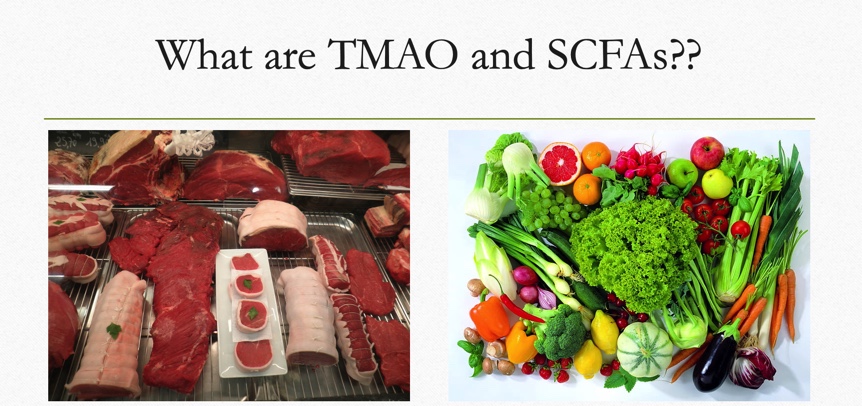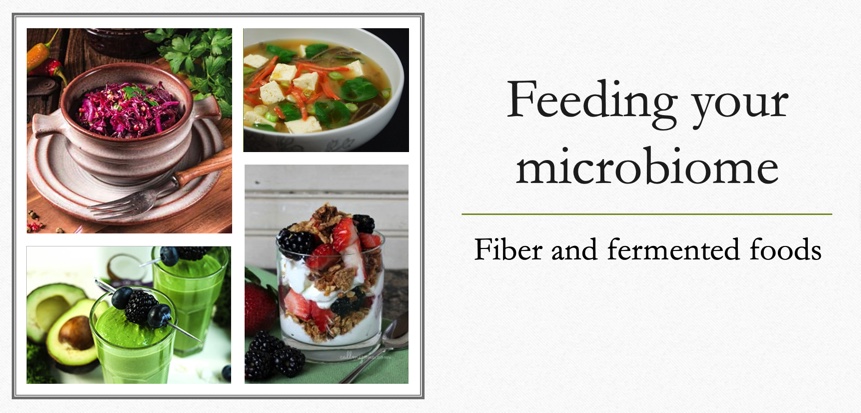Written by Marsha Seidelman, M.D.
June 30, 2021
Last week, we ended by saying that we determine the makeup of our microbiome by what we eat. We’ve been aware of the benefits of fruits and vegetables for a long time. The microbiome has been the secret helper we never knew.

This is the meat of the matter, so to speak.
Carnitine is found in meat; choline is found in eggs, seafood and poultry. Both can be metabolized by microbes into TMA (trimethylamine), then metabolized by us into TMAO (trimethylamine oxide). TMAO increases the risk for cardiovascular disease in two major ways. It changes how sensitive the body is to depositing cholesterol in tissues, without necessarily changing the cholesterol level in the circulation. And it alters platelet function, making platelets more sticky and more active. It takes less of a trigger to get robust clotting. This combination is what blocks arteries to cause a heart attack or stroke. We’ve known for decades that eating red meat is associated with increased heart disease. TMAO may be a part of the reason why.
Animal products in increasing order of stimulating TMAO production are: white meat chicken, dark meat chicken, pork, veal and lamb, red meat. Carnitine is also marketed as a supplement. I would urge caution about using it.
Fiber, found in plant products, can not be digested by human enzymes. Instead, it makes the journey all the way through the many feet of small intestine, to the colon, where it is clipped into sugars by bacteria – ones that thrive on fiber. They ferment these sugars and produce short chain fatty acids (SCFAs). These are generally beneficial, with a role in production of serotonin and dopamine (feel-good neurotransmitters), vitamins and anti-inflammatory compounds; they are involved in the immune system, barrier function of the intestines, and more.
Meat-eaters have certain predominant bacteria that are better at producing TMAO, while vegans favor other bacteria that flourish on fiber to create helpful SCFAs. The microbiome can change over the course of days or weeks with a change in diet, but will then revert back to the previous state if that diet is not maintained.
Feeding your microbiome – fiber and fermented foods – also known as Prebiotics and Probiotics.

Prebiotics – Foods containing fiber. The goal is to shift the composition and metabolic activity of the microbes toward less inflammation and improved function of the gut-barrier function and gut-brain axis. Only plants contain fiber. The entire supermarket produce section should say “Contains Prebiotics”!
Choose fruits, vegetables, whole grains and legumes, especially onions, garlic, leeks, leafy greens, kale, chicory (an endive with curly bitter leaves; radicchio is a red-leafed Italian chicory), oats, honey and maple syrup. These particular foods are rich in inulin, which is a special chain of fructose molecules that travels through the gut unchanged until the colonic bacteria breaks them down and ferments them. Inulin is sometimes added to processed foods. Although it is good for you, it can increase stools or gas.
Probiotics – Fermented foods that contain live cultures. They promote the production of beneficial enzymes, B vitamins and omega 3 fatty acids in the colon. Studies suggest that probiotic foods might ease lactose intolerance, and they may decrease gas and diarrhea, although they might also cause it. Some examples are:
Yogurt – Fermented milk. Live cultures. Non-dairy yogurts also list live cultures. Kefir – Fermented goat, sheep or cow milk. Shepherds found that the milk they carried tended to ferment into a thick, bubbly liquid — thick, creamy, tangy, like yogurt. It has bacteria and yeast. Sauerkraut – Fermented cabbage. Refrigerated, not the shelf stable kind. Unpasteurized, since pasteurizing kills active good bacteria.
Kimchi — A spicy Korean cabbage dish, loaded with vitamins.
Miso – Fermented soybean paste.
Kombucha – Fermented black tea.
Tempeh – Made from a base of fermented soybeans. High in protein, with a smoky nutty taste. My favorite fermented food.
The Cleveland Clinic website is an excellent source of information on this topic. “What we eat is probably the biggest influence on our gut microbiome.” They offer the following guidance on the over-the-counter probiotic pills.
Probiotics should be a strain of bacteria that is isolated from humans and can survive through the acid and bile to get to the colon. These must be deemed safe to use and have validated beneficial effects. Most probiotics on the market do not meet those criteria. Also, the same probiotics are not helpful to everyone. If there’s a strain listed, that is usually a good sign that it has been tested. Use it only for what it has been demonstrated – ‘help immunity’, ‘bowel health’, etc.
Each probiotic contains a different strain. For instance:
Align – Bifidobacterium infantis.
Florastor – Saccharomyces boulardii.
Culturelle – Lactobacillus rhamnosus.
Each probiotic can itself cause bloating, gas and stool changes.
Whether a particular one is the right one for you is unknown. You can try one, and if there are no results after a few weeks, switch to a different one. Probiotics are not a replacement for eating good foods but might be helpful in ADDITION. The current stand is that there’s no need to take a probiotic to counteract a course of antibiotics. If you choose to take one, it should be after the antibiotic course has been completed.
This should give you food for thought! And next week we’ll talk about postbiotics and what we know about the microbiome contributing to health and illness. Eat well! And have a good 4th of July weekend!!
Tags: colon, fermented foods, fiber, microbiome, prebiotics, probiotics, SCFA, TMAO
